In the footsteps of Monet - part 5
Continuation. Start here:
HONFLAIR
The road from Etretat to Honfleur passes by one of the largest French ports - Le Havre. It has been twinned with my hometown for half a century. But it was not possible to see him even from afar. From the Normandy Bridge, where we stopped, it is almost invisible. The estuary of the Seine is quite wide and long, and the port is already on the English Channel. One could only imagine that somewhere behind the pipes is this young city by the standards of France, whose new houses built after the war are included in the UNESCO World Heritage List and which, as they say, became one of the prototypes of our Khrushchev houses (another one is the German Bauhaus style ).
The Normandie Bridge connects Upper and Lower Normandy. For the first time I saw a cable-stayed bridge in my school years. It was a bridge over the Daugava.
Since then, it is cable-stayed bridges that are dearer to me than others. The bridge over the Seine was opened in the late 90s. It is over 2 kilometers long.
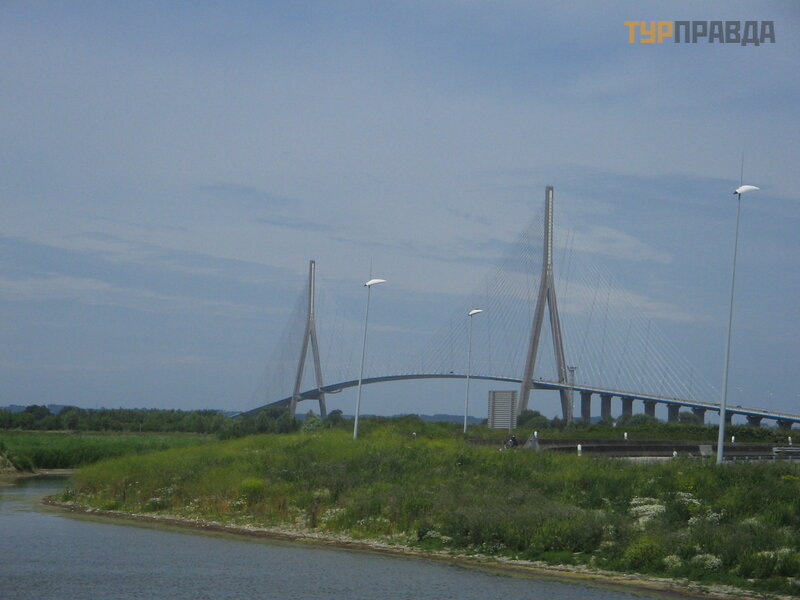
There is a nature reserve at the mouth of the Seine, which can be seen from the observation deck. And next to the bridge, you can also see some structures that help to understand how this structure is technically made (called the "engineering park").
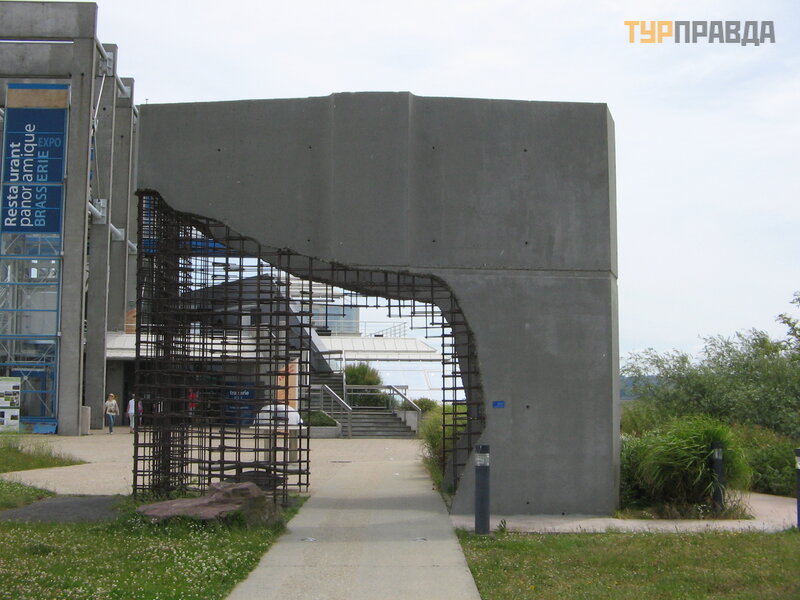
From the bridge you can also see Honfleur, where we are heading. The city is located in the department of Calvados.
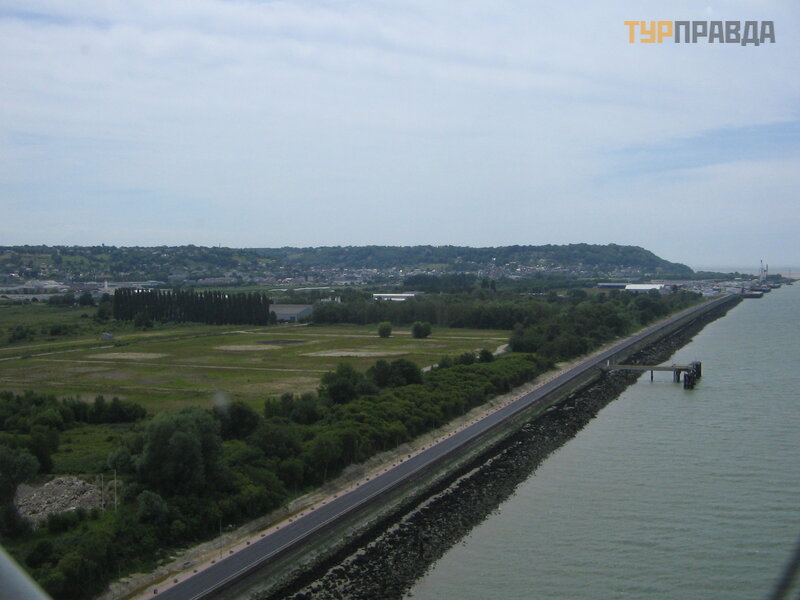
The city miraculously escaped the bombings of World War II, in which all the coastal cities of Normandy were badly damaged. That is why almost all the houses from the time of Minister Louis XIV Colbert located near the Old Harbor on the Embankment of Catherine are architectural monuments.
It was these slate houses that were repeatedly depicted on the canvases of various artists (Boudin, Courbet, Monet, etc. ).
It is assumed that the name of the city is of Anglo-Scandinavian origin: from the words "wave", "estuary" (-fleur) - the same origin of the modern words "fleet" and "fjord"; and “horn”, “corner” (hon-), since the river flowing into the Seine really has a bend here, however, they still consider it more likely to originate from their own name.
The first written mention of the city dates back to the time of the Duke of Normandy Richard III (uncle of William the Conqueror). At that time, Honfleur was an important port on the route from Rouen to the English coast.
During the Hundred Years' War, the French king Charles V fortified the town of Harfleur on the other side of the Seine opposite Honfleur, trying to block the entrance to the river for English ships. This did not save Honfleur from being conquered by the British.
But since then, it was from this port that raids (including raiders) were carried out on English coastal lands.
After the end of the war, Honfleur grew rich and built. Then the already unnecessary protective structures were demolished and the harbor, today called the Old, was deepened. It was an important sea and fishing port. Ships were built here. From here long-distance expeditions began. During one of the expeditions, a native of Honfleur, Champaigne, founded Canadian Quebec.
The loss of the American colonies, the post-revolutionary Napoleonic blockade of Great Britain, the growth of the new port of Le Havre, and then the shallowing of the harbor due to sand drifts greatly and permanently weakened the city. Honfleur was impoverished and depopulated. In the 19th century, due to the cheapness of housing and the appearance of the railway, poor artists were able to settle here. They breathed life into the city, made it famous in the artistic environment (and artistic life in the city continues today).
All houses on the St. Catherine's Embankment in the Old Harbor, the Old Harbor itself, the Church of St. Catherine, the Church of St. Leonard (destroyed during the religious wars, reconstructed in the 17th-18th centuries), the Church of St. Etienne, lieutenant's house, salt storages (you know that salt was sometimes more expensive than gold? ).
The Old Harbor was deepened by order of Colbert in 1681. The buildings on the embankment of St. Catherine were built mainly in the 17th-18th centuries, on the side of the Lieutenant's House - the oldest, the 16th century. They are narrow, three to seven stories high. Most are covered with slate. They are located on the site of old ditches from the time of Viscount Auge (viscounts were called officials of the Dukes of Normandy). On the embankment of St. Etienne are the city hall, the maritime museum in the church of St. Etienne.
There is only one building on the Quarantine embankment - the lieutenant's house; here is a drawbridge for leaving the harbor of yachts standing in the harbor and an old carousel (as in cartoons).
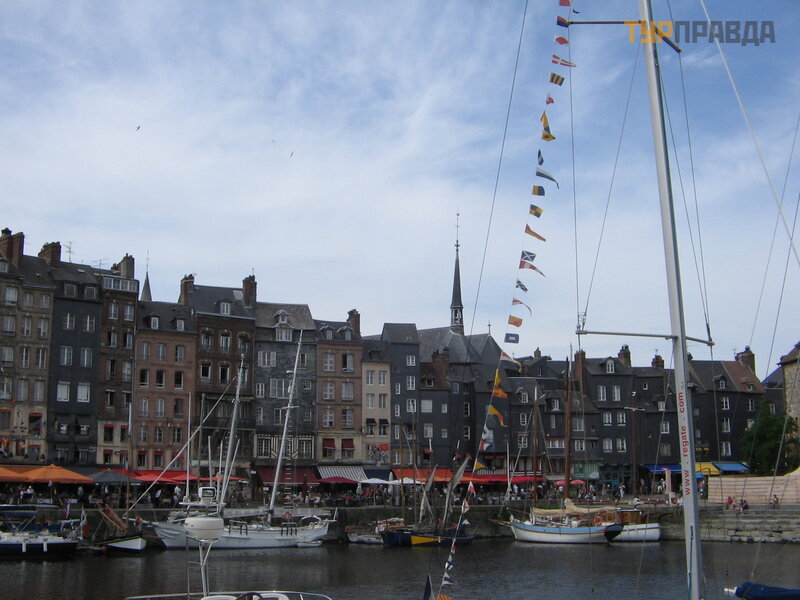
The wooden church of St. Catherine was consecrated in honor of Catherine of Alexandria. Her wooden image is above the entrance. This is the largest wooden French church. It was built instead of the stone one destroyed during the Hundred Years War. The church has a strange architecture. Usually churches have one or three naves. Here are two of them. A tower with a cross stands on one of them. But inside the hall is almost uniform (pillars have a constructive role, but the space is united). The older nave dates from the 15th century. (built after the Hundred Years War). The second was added in the 16th century. due to lack of space in one nave.
The church is built on the model of a typical market (like the market in Etretat), which, in turn, resembles an inverted ship in design. There are two reasons for this: 1) the very first Christian churches were a reminder of Noah's ark; 2) the churches of Normandy were often made of wood, and the builders were shipbuilders who are used to this model. They built such structures without using a saw, only with axes. Approximately as depicted on the Bayeux carpet.
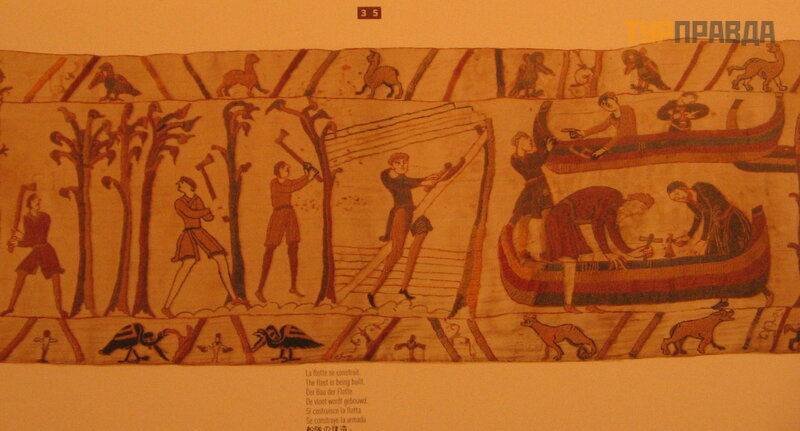
The tower (also made of wood) stands separately for fire reasons. This is not typical for the Norman style (usually the tower in them is located on the middle cross). The whole church is covered with chestnut shingles.
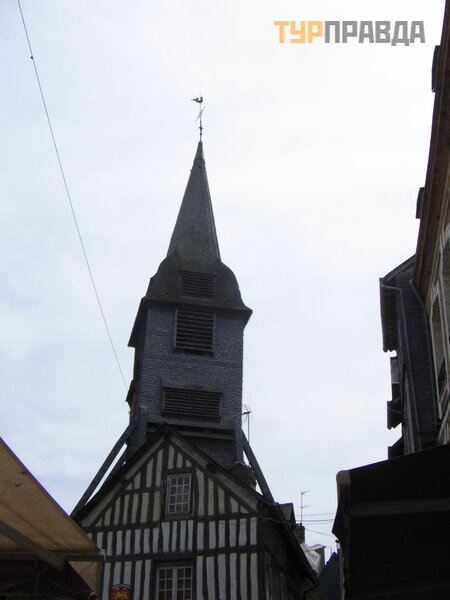
Church of St. Etienne is the oldest in Honfleur. It contains elements of the XIV-XV centuries. Now it houses the Maritime Museum, opened in 1976.
And after the revolution, when all religious institutions were closed, there was a shop, a theater, a herring exchange, and a customs office.
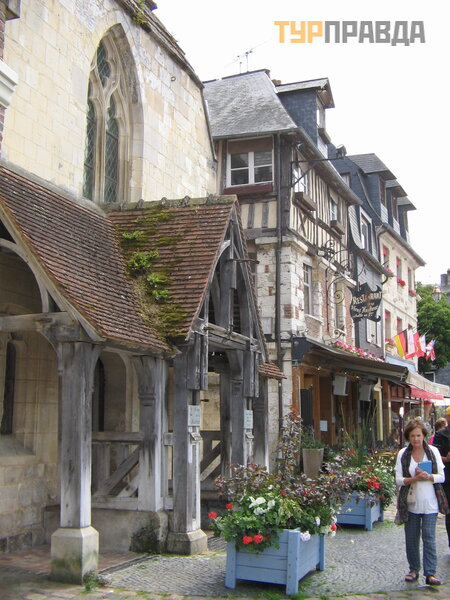
Lieutenant's House - the remains of old fortifications (XVI-XVII centuries). During the time of the Norman dukes, the Caen gate of the fortress of Honfleur was here. Rebuilt in the 17th century, surrounded by turrets with the coat of arms of the city. There was also a statue of the Virgin of the Port. A lieutenant was an official from the time of Louis XIV. This house was his home. Unfortunately, at the time of our visit, everything was covered with scaffolding and was poorly visible.
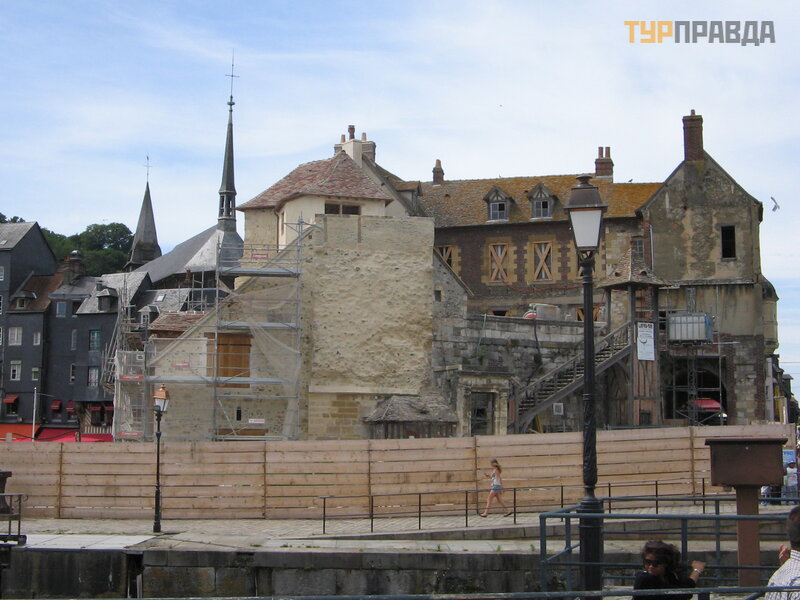
In addition to the mentioned maritime museum, the city has several museums: the artist Eugene Boudin (he was born here; it was he who instructed the young Monet and then followed his career, but he himself was not an impressionist), composer and pianist Eric Satie (in the house where he was born; a friend of Sati lived nearby - the writer Ale), Old Honfleur (ethnographic).
Charles Baudelaire regularly visited his mother here. Another celebrity "from the artistic world" is associated with Honfleur - the writer Francoise Sagan, who lived in Ekmovil. Despite her fame, she died in poverty in a city hospital.
Next, we went for a tasting of the drink, which got its name from the department where we were located - Calvados and technologically related cider and pommo. Therefore, a few words about these drinks.
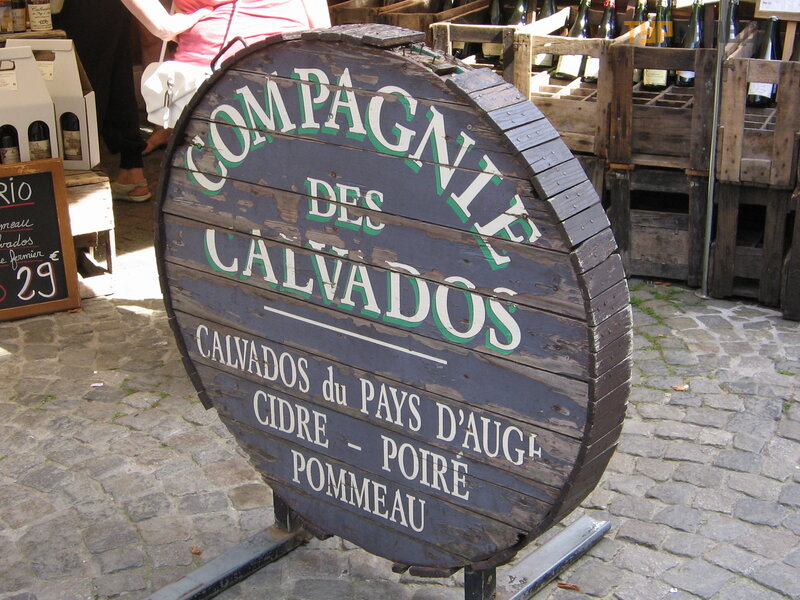
Cider is a fermented drink made from apples or pears, containing between 2 and 8% alcohol (sometimes the range is wider - from 1 to 18%). Ciders are "table" and "bottled"; "sweet" (3°), "semi-sweet" (3-5°), "sour" (brut) (5°), "traditional" (more than 5°). For production, three types of apples are mixed: sweet, sour and bitter.
The history of the future cider begins in ancient times. Jews, Greeks, Romans drank apple drinks. The Romans were succeeded by the Basques in Spain. They mixed water, apple slices and honey. Basque sailors sailed the Bay of Biscay. So the drink came around in the XII-XIII centuries to Brittany and Normandy. Although some apple drinks, apparently, were drunk here before (names of settlements speak about the existence of apples).
But there is also a legendary version of the appearance of an apple drink in France. Allegedly, Charlemagne brought him to the Frankish lands. Once he wanted to drink at night, he went to look for something.
In the dark, he slipped in the basement, wet his hands with something, tried it - it was a sweet drink that he liked. Apparently, this happened during his sad campaign in Pomplona, which is described in the Song of Roland.
Different kinds of rules about apple orchards in France appear in the XII century. At the same time, the word "cider" is first encountered. The heyday of the use of cider came in the XIV century. At this time, cider was drunk several times more than beer. After the invention of the press, the production of cider began to develop. It is believed that the Basque nobleman Guillaume Dursus, who served King Louis XII (successfully because he received land in Normandy) in the 16th century. spread new varieties of apples from the north of Spain and improved the technology of cider production. At this time, beer was made and drunk by the poor, and cider by the wealthy. Now beer is more expensive than cider, which is why its consumption is increasing.
Calvados is an apple vodka distilled from cider. It was first written about him in the 16th century. in the newspaper of Gilles Goubertville. In 1600, the first corporation of drink manufacturers appeared. But most of the Calvados was still made by farmers for personal consumption. Then on the roads of Normandy moved mobile distillers, which were used by farmers. In the 19th century, when phylloxera destroyed most of the vineyards, Calvados became the most popular drink.
The strength of the drink is 40-45° (legally permitted), although there are also 55°. It is made from apple or pear cider. After distillation, the drink is aged for 2 years in oak barrels, acquiring its aroma and color. A 2-year-old drink is already considered a Calvados. But some drinks have been produced for longer. Moreover, unlike wines, Calvados is poured and mixed. There are restrictions on the fortress, so that there is no spread of alcoholism.
Pommeau is a drink with a strength of 16-18 °. In its production, Calvados and unfermented apple juice are mixed. Take 2/3 apple must and 1/3 calvados. The drink retains the color acquired by Calvados; apple smell and taste are added to it.
We started tasting with cider and ended with Calvados. Cider is a drink for those who love different pops. I don’t like such drinks, so I drank cider on a trip like the French do: with pancakes. Calvados was too strong for me; I just couldn't bring myself to drink it. But I liked the pommeau. Fortress wine, apple taste is felt.
All of these drinks are widely used in northern French cuisine. There is such a term "Norman hole". It means the interval between dishes, when they drink Calvados for better digestion. It is believed that it makes room for the following dishes. And this is very important on holidays, where there is a plentiful table.
There is a cider museum on the Cotentin peninsula in Valoni (near Cherbourg). Those interested can get acquainted with the production in more detail.










